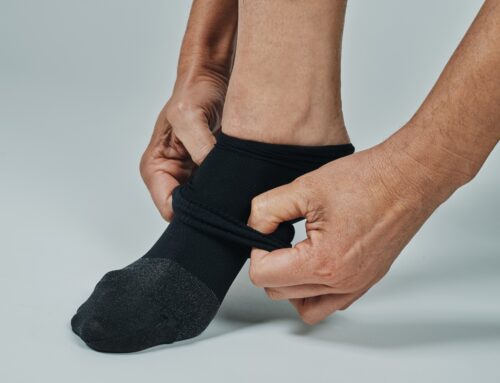Restless Leg Syndrome (RLS), also known as Willis-Ekbom Disease, manifests as an uncontrollable urge to move the legs, typically caused by uncomfortable sensations. These sensations, often described as throbbing, pulling, or creeping, tend to worsen during periods of inactivity, such as at night. This condition disrupts sleep and impacts the quality of life, making even simple relaxation a challenge. Compression socks for restless legs offer a therapeutic solution for those suffering from this condition.
Specifically designed to aid individuals with RLS, compression Socks apply gentle pressure to the legs. This pressure promotes blood flow, reduces venous pressure, and decreases the symptoms of RLS. By improving circulation, compression socks help to minimize discomfort and the urge to move the legs, providing relief during times when symptoms typically escalate.
What is Restless Leg Syndrome?

The impact of RLS on daily life extends beyond just sleep disruption. It can impair an individual’s quality of life by causing daytime fatigue, mood disturbances, and reduced productivity.
People with severe RLS may find it challenging to participate in activities that require prolonged sitting, such as traveling, attending meetings, or watching movies.
Causes of Restless Leg Syndrome
RLS can be triggered by a variety of factors, and in many cases, the exact cause is not clear. However, certain common triggers and underlying health issues have been identified:
- Genetic Predisposition: Family history plays a significant role, with the condition being more prevalent in those who have close relatives with RLS.
- Iron Deficiency: Low levels of iron in the brain can disrupt its functioning, leading to RLS symptoms.
- Chronic Diseases: Kidney failure, diabetes, and peripheral neuropathy are associated with a higher incidence of RLS.
- Pregnancy: Some women experience RLS during pregnancy, especially in the last trimester, although it usually resolves after delivery.
In addition to these triggers, lifestyle factors also significantly influence the occurrence and severity of RLS:
- Medications: Certain medications such as antihistamines, antidepressants, and anti-nausea drugs can exacerbate symptoms.
- Substance Use: Alcohol, nicotine, and caffeine can trigger or worsen RLS symptoms.
- Lack of Exercise: A sedentary lifestyle may increase the risk of developing RLS, while moderate exercise often helps reduce symptoms.
The Science Behind Compression Therapy for RLS
Compression therapy has become a recognized approach for managing the symptoms of Restless Leg Syndrome (RLS). This therapy involves wearing specially designed Compression Socks that apply consistent pressure to the legs. This pressure aids in improving blood flow, which is crucial in the alleviation of RLS symptoms.
- Enhanced Circulation: Compression socks help to push blood up from the legs back to the heart, countering the effects of gravity. This increased circulation prevents blood from pooling in the veins of the lower legs, which is often a contributor to the discomfort associated with RLS.
- Reduced Venous Pressure: By compressing the surface veins, arteries, and muscles, the socks make the blood in both superficial and deeper veins flow more efficiently. This can reduce the venous pressure, decrease swelling, and alleviate the sensations that provoke the urge to move the legs.
- Muscle Stabilization: Compression socks also help stabilize the muscles and decrease the build-up of lactic acid, which can further reduce discomfort and restlessness.
The benefits of using compression therapy for RLS are significant and can include:
- Symptom Relief: Many individuals experience a reduction in the severity and frequency of RLS symptoms with regular use of compression socks, particularly during times typically associated with worse symptoms, like the evening or overnight.
- Improved Sleep: By mitigating the symptoms of RLS, compression socks can help sufferers achieve a more restful and uninterrupted sleep.
- Better Quality of Life: With reduced symptoms and improved sleep, individuals often experience an overall improvement in their quality of life.
Types of Compression Socks Available
Various types of compression socks offer different levels of pressure, measured in millimeters of mercury (mmHg).
- Light Compression (15-20 mmHg): Ideal for mild RLS symptoms, these socks can be worn daily to help alleviate discomfort.
- Moderate Compression (20-30 mmHg): Suitable for moderate to severe symptoms, medical professionals often recommend these socks for individuals with chronic RLS to significantly benefit their condition.
- High Compression (30-40 mmHg and above): Typically prescribed for severe cases, these should be used under close medical supervision.
Choosing Compression Socks for Restless Legs
Selecting the right compression socks is crucial not only for comfort but also for ensuring the effectiveness of the therapy for Restless Leg Syndrome (RLS).
- Compression Level: As previously discussed, compression socks come in varying degrees of tightness, measured in mmHg. Choose a compression level suitable for the severity of your RLS symptoms, generally starting at a lighter compression and adjusting as needed.
- Purpose and Usage: Consider when and where you will wear the socks. If you need them primarily for nighttime relief, comfort might be prioritized. For daytime and active use, look for durability and moisture-wicking properties.
- Material: Compression socks are made from a variety of materials, including nylon, cotton, spandex, and blends. Each material offers different benefits, such as breathability, comfort, and ease of care. Choose a material that suits your lifestyle and skin sensitivities.
- Size and Fit: Proper fit is essential. Ill-fitting compression socks can either be too constrictive or ineffective if too loose. Use accurate measurements of your ankle, calf, and leg length to select the right size.
- Consulting a Professional: It’s advisable to consult with a healthcare provider or a specialist in compression wear to choose the best socks for your needs, especially if you have underlying health issues.
Ensuring a Proper Fit
- Measure Early: The best time to measure your legs for compression socks is in the morning before swelling can occur. Measurements should include the widest part of your calf, the length from the floor to the bend of your knee, and the circumference of your ankle.
- Check for Uniform Compression: The socks should feel snug but not painfully tight, with the pressure evenly distributed from ankle to knee.
- Wear and Test: Try the socks for a few hours to ensure there is no discomfort or bunching, and that they do not slip down, which can diminish the therapeutic benefits.
Care-Med’s Custom Solutions
At Care-Med, we provide a comprehensive range of compression wear specially designed to meet the unique needs of individuals suffering from Restless Leg Syndrome and other vascular conditions.
We take a highly personalized approach to compression therapy, recognizing that effective treatment goes beyond a one-size-fits-all solution. We custom-fit each pair of our compression socks, carefully tailoring them to the individual measurements of our clients for maximum comfort and effectiveness.
Our experienced professionals dedicate themselves to helping clients select the right products from our extensive range, considering factors such as the severity of their symptoms, lifestyle needs, and personal preferences. We extend comprehensive support beyond the sale of our products to ensure our clients achieve the best possible outcomes in managing their symptoms.
Living with Restless Leg Syndrome
Living with Restless Leg Syndrome (RLS) can be challenging, but there are several lifestyle adjustments and home remedies that can help manage the symptoms effectively. Incorporating these strategies into your daily routine can reduce discomfort and improve your quality of life.
Lifestyle Adjustments and Home Remedies
- Maintain a Regular Sleep Schedule: Establishing a consistent bedtime routine and maintaining a comfortable sleep environment can help mitigate the symptoms of RLS. Aim for a cool, quiet, and dark room and try to go to bed and wake up at the same time every day.
- Moderate Exercise: Regular physical activity can significantly reduce RLS symptoms, but it’s important to avoid over-exertion, which might worsen the symptoms. Activities like walking, yoga, and stretching are beneficial.
- Leg Massage: Gently massaging your legs can help soothe the nerves and muscles. Incorporating essential oils like lavender or peppermint might provide additional relief.
- Warm or Cool Compresses: Applying warm or cool compresses to your legs can help ease muscle spasms and discomfort associated with RLS.
- Avoid Triggers: Limit consumption of caffeine, alcohol, and tobacco, as these substances can exacerbate RLS symptoms. Also, review any medications with your doctor that might be contributing to or worsening your symptoms.
- Relaxation Techniques: Techniques such as meditation, deep breathing, and progressive muscle relaxation can help reduce stress and improve your overall sleep quality.
Consulting Healthcare Providers
While home remedies and lifestyle adjustments can play a significant role in managing Restress Leg Syndrome (RLS), consulting with healthcare providers is crucial for a holistic approach to RLS management. RLS symptoms can sometimes mimic those of other conditions, making it essential for healthcare providers to conduct necessary tests to confirm the diagnosis accurately.
Depending on the severity of your symptoms and overall health, a healthcare provider can devise a personalized treatment plan that may include medications, recommended lifestyle modifications, and other therapeutic strategies.
Regular follow-ups are vital, as they allow your healthcare provider to monitor the progress of your treatment and make necessary adjustments. This ongoing oversight is critical for effectively managing RLS symptoms over the long term.
Relief with Socks for Restless Legs
In managing Restless Leg Syndrome (RLS), the choice of the right compression socks can significantly alleviate the discomfort and urge to move that define this challenging condition. By enhancing circulation, reducing venous pressure, and providing muscular support, compression socks are a key non-invasive treatment option that can improve your daily comfort and night-time rest.
For those seeking effective relief from RLS, personalization in compression wear is crucial. Custom-fitted compression socks, tailored to your specific measurements and needs, ensure the most beneficial results. This is where Care-Med excels. With over 18 years of dedicated service, we specialize in providing not only high-quality products but also a personalized service that sets us apart.
Take the first step toward managing your RLS effectively by reaching out to Care-Med. Let us help you find the comfort and relief you deserve.
Share This Story, Choose Your Platform!
Table of Contents
We specialize in orthotics, body braces, and compression wear tailored to your unique needs in Toronto. Reach out to us at info@caremed.care or call 416-782-5353 to book your fitting and consultation.
Experience the difference of customized solutions designed just for you.











